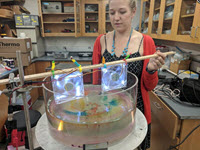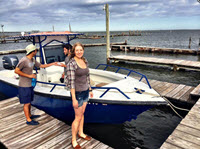
Ocean models that utilize surface drifter data can provide oil spill responders with important information about the floating oil’s direction and speed as it moves along the ocean surface. However, surface drifters, like the floating material they represent, tend to cluster along strong fronts and eddies. This clustering can result in important consequences for surface drifter turbulence and transport data at smaller scales. Jenna Pearson is investigating the extent that material clustering impacts the accuracy of turbulence calculations and searching for potential factors or processes involved.
Jenna is a Ph.D. student with Brown University’s Department of Earth, Environmental and Planetary Sciences and a GoMRI Scholar with the Consortium for Advanced Research on Transport of Hydrocarbon in the Environment II (CARTHE II).
Her Path

Jenna developed her scientific interests as an undergraduate student at Northeastern Illinois University. While working as a math tutor, she decided to major in Mathematics after a pre-calculus professor encouraged her to pursue it as a career. She added Earth Science as a second major after serving as an Army National Guard medic in Iraq during her undergraduate studies. “I was only deployed for about a year, but I was a medic for eight years in total,” she said. “I transitioned from being a medic to a math and science major because there were more tools at my disposal to help global populations, rather than just treating a handful of individuals at a time.”
Jenna gained experience using math and science to solve larger problems through summer research programs. She participated in the 2013 Harvard School of Public Health Summer Program in Epidemiology with Dr. Alkes Price, where she used statistical methods to infer consistency across genetic variants associated with increased Type II Diabetes risk. The following year, she spent two summer months with Dr. Bjorn Sandstede at Brown University’s Division of Applied Mathematics, where she modeled microscopic and macroscopic traffic flow. While there, she learned about various tools used for modeling dynamic systems and how to apply data assimilation schemes.
During her summer at Brown University, Jenna met with Dr. Baylor Fox-Kemper who felt that her skillset would fit well with his CARTHE research, and she joined his team as a Ph.D. student in 2015. “The transition to CARTHE-related work was natural because of my desire to look at environmental problems,” said Jenna. “My summer research at Brown involved incorporating Eulerian and Lagrangian data into traffic models, which led me look specifically at the drifters and think critically about the types of statistics we were looking at.”
Her Work

When examining fluid motion, researchers use a Lagrangian approach (such as drifters) to trace how ocean surface waters flow through an area over time and a Eulerian approach (such as a fixed buoy or weather station) to observe fluid dynamics at a specific location. Jenna initially studied drifters similar to those deployed during CARTHE’s Grand Lagrangian Deployment (GLAD) experiment and Lagrangian Submesoscale Experiment (LASER). She assessed the drifters’ behavior using velocity structure functions to better understand turbulence in a study area. She and her colleagues compared their statistics to those from a Eulerian model and noticed that the drifter-derived Lagrangian functions represented unrealistic conditions compared with other CARTHE research.
Jenna used an algorithm to determine that this disagreement occurred because surface drifters are “biased” at smaller scales when compared to Eulerian calculations, meaning that they don’t sample the velocity field equally at all times. She observed that the convergence of drifters into special flow structures, such as fronts, skews the Lagrangian statistics away from the Eulerian ones. “Previous studies show that drifters tend to cluster in regions of strong frontogenesis or can remain trapped in persistent eddies, leading them to only sample certain portions of the velocity field at a given time,” she explained. “We have found that velocity structure functions are biased below 10 km, but agree at scales above that mark. This means good things for people who would like to know mesoscale statistics, but also means that statistics below 10 km need to be cautiously interpreted.”
Jenna’s team is currently working on an observational study that pairs data from LASER drifters and X-band radar to validate these findings and determine the extent that clustering impacts results. Their preliminary results are consistent with their previous observations. They plan to incorporate more descriptive statistics and probability density functions to determine why bias occurs at smaller scales and how much of the Eulerian-Lagrangian difference can be contributed to this sampling bias. Jenna hopes that her research will help researchers collect and interpret drifter data more accurately, particularly for use in tracking spilled oil and algal blooms.
“A suite of biogeochemical floats is currently being released in various parts of the global ocean. There is then a question as to whether or not we can trust that these drifters represent the entire velocity field or if the statistics we wish to calculate from them may be biased because of their sampling behavior,” said Jenna. “Alongside my assessment of the Eulerian-Lagrangian differences, I am also developing a new theory related to structure functions and spectra that allows us to use biogeochemical data in a similar fashion to conservative tracers like temperature. This will hopefully give a better picture of what is happening in the upper ocean.”
Her Learning
Jenna’s time at the Fox-Kemper lab was a positive experience that helped her grow academically and as an individual. Conducting field work and attending conferences with her colleagues highlighted the deep connection between her interests in public health and ocean health and sparked her desire for future coastal dynamics and ocean biogeochemistry projects. Teaching opportunities during her doctoral research helped her develop a strategic and tested teaching method while learning more about her own field. “I also fine-tuned my music skills by singing and playing guitar in our Fox-Kemper Lab-wide band!” she said.
Her Future
Jenna is applying for post-doc positions and hopes to continue teaching and conducting research as a professor. Before she graduates, she will return to the Summer@Brown Program and teach the course “Studying the Ocean from Blackboard to Drones” to college-bound high school students. She encourages high school students to take diverse science courses and speak with researchers in different fields to get a good sense of what a scientific career path may entail. “We are always learning and questioning our environment, and it can take some time for you to find what makes you get up in the morning,” she said. “Remember: it is your path, and you should define it.”
Praise for Jenna
Dr. Fox-Kemper described Jenna as an incredibly hard-working and determined student and researcher whose work addresses a fundamental paradox of the CARTHE research: that Lagrangian statistics (from drifters) and Eulerian statistics (from gridded models) seemed to disagree at the submesoscale range. He explained that her research was initially difficult to publish, and she received skeptical feedback from reviewers because her results had substantial implications for drifter-based science. Jenna pushed through the obstacles, resulting in a stronger paper and important realizations about removing model uncertainties.
Dr. Fox-Kemper also reflected on her creative and fun-loving nature around the lab, “She’s famous for making science-themed cakes to celebrate defenses and prelims! A recent one involved green-colored goldfish crackers to indicate the effects of hypoxia. She’s a great presence in our lab.”
The GoMRI community embraces bright and dedicated students like Jenna Pearson and their important contributions. The GoMRI Scholars Program recognizes graduate students whose work focuses on GoMRI-funded projects and builds community for the next generation of ocean science professionals. Visit the CARTHE website to learn more about their work.
By Stephanie Ellis and Nilde Maggie Dannreuther. Contact sellis@ngi.msstate.edu for questions or comments.
************
The Gulf of Mexico Research Initiative (GoMRI) is a 10-year independent research program established to study the effect, and the potential associated impact, of hydrocarbon releases on the environment and public health, as well as to develop improved spill mitigation, oil detection, characterization and remediation technologies. An independent and academic 20-member Research Board makes the funding and research direction decisions to ensure the intellectual quality, effectiveness and academic independence of the GoMRI research. All research data, findings and publications will be made publicly available. The program was established through a $500 million financial commitment from BP. For more information, visit https://gulfresearchinitiative.org/.
© Copyright 2010-2019 Gulf of Mexico Research Initiative (GoMRI) – All Rights Reserved. Redistribution is encouraged with acknowledgement to the Gulf of Mexico Research Initiative (GoMRI). Please credit images and/or videos as done in each article. Questions? Contact web-content editor Nilde “Maggie” Dannreuther, Northern Gulf Institute, Mississippi State University (maggied@ngi.msstate.edu).
